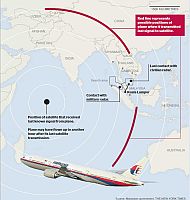 It appears that the British satellite firm, Inmarsat, combined high tech analysis with very basic navigation to estimate the flight path of MH370, after all other other searchers had failed to find the plane.
It appears that the British satellite firm, Inmarsat, combined high tech analysis with very basic navigation to estimate the flight path of MH370, after all other other searchers had failed to find the plane.
The Prime Minister of Malaysia announced yesterday that Flight MH370 had crashed in a remote area of the Indian Ocean with no survivors. Debris, which may be from the 777 jet liner which disappeared on March 8th, has been sighted by satellite imagery and by search planes. So far, however, no debris has been recovered as a cyclone in the area has turned back ships attempting to collect and identify the debris.
So how did Inmarsat locate the probable flight path of the doomed jet-liner? For reasons yet unknown, the transponders and communications devices that could otherwise be used to track the plane were shut off around the time that the plane disappeared. Nevertheless, there was a plane monitoring system that sent an hourly signal or “ping” to a satellite. The monitoring service is subscription based and Malaysia Air had chosen not to subscribe to the service. All the same, the system automatically sent a “ping” to the satellite which would have connected the plane to the service, if the airline had chosen to subscribe.
The old cliche about locating something that is difficult to find is that one is “looking for a needle in a hay stack.” The problem has been with the Malaysian Flight MH370 is that they must first find the haystack. Inmarsat needed to comb though mountains of data to identify and analyse the hourly pings from the missing plane. When they located the “pings” they were able estimate the distance of the plane from the satellite by measuring the time that the signal took to travel from the plane and back.
Any navigator knows that to establish a fix, a position on the globe, one needs either a bearing and a distance or multiple bearings. Once Inmarsat estimated the distance between the plane and the satellite, they had one piece of the puzzle and could estimate a circular line of position. The plane had to have been somewhere along the arc defined by the projected distance, when it pinged the satellite. By analyzing multiple pings and considering other search results, the engineers at Inmarsat were able to estimate within roughly 100 miles where they thought the plane went down, which they believe was on the southern portion of the arc in the Indian Ocean roughly 1,500 mile off Perth Australia.
After the extensive data searching and analysis, Inmarsat ultimately estimated the position using the same basic techniques used by a navigator with a sextant and a chrometer. A navigator would use a sextant to measure the angle between a celestial object and the horizon, whereas Inmarsat used highly accurate clocks to estimate the distance. Nevertheless, the technique and the results are roughly the same.
Now we will have have to wait for the weather to clear before any remaining debris can be identified. It appears that Inmarstat may have helped find the haystack. Even so, the wreckage of MH370 is still a very small needle in a large ocean.

The orbit of the INMARSAT satellite (inclined at 1.66° to the equator) which leads to a latitude-dependent Doppler shift with a 24 hour period, the velocity and orientation of the plane (the moving platform Doppler shift is a function of position, speed and heading), and the short-term stability of the carrier frequency from the plane’s transmitter, including considering possible variations in the power supply voltage. There will be a cluster of velocity-dependent positional solutions for each ping, which can be evaluated for a unique consistent solution for a plane’s route, if one exists. If the transmitted frequency varies at source and/or if the plane’s route and speed varied erratically then there may be no unique solution.